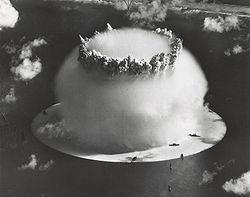
Back سباق التسلح النووي Arabic Нуклонсарла ăмăрту CV مسابقه تسلیحات هستهای Persian Course aux armements nucléaires French Nukleáris fegyverkezés Hungarian Միջուկային սպառազինությունների մրցավազք Armenian Perlombaan senjata nuklir ID Corsa agli armamenti nucleari Italian 핵 군비 경쟁 Korean Branduolinio ginklavimosi varžybos Lithuanian

| Nuclear weapons |
|---|
 |
| Background |
| Nuclear-armed states |
|
The nuclear arms race was an arms race competition for supremacy in nuclear warfare between the United States, the Soviet Union, and their respective allies during the Cold War. During this same period, in addition to the American and Soviet nuclear stockpiles, other countries developed nuclear weapons, though no other country engaged in warhead production on nearly the same scale as the two superpowers.
The race began during World War II, dominated by the Western Allies' Manhattan Project and Soviet atomic spies. Following the atomic bombings of Hiroshima and Nagasaki, the Soviet Union accelerated its atomic bomb project, resulting in the RDS-1 test in 1949. Both sides then pursued an all-out effort, realizing deployable thermonuclear weapons by the mid-1950s. The arms race in nuclear testing culminated with the 1961 Tsar Bomba. Atmospheric testing was ended in the 1963 Partial Nuclear Test Ban Treaty. Subsequent work focused on the miniaturization of warheads at LLNL and VNIITF, and the neutron bomb.
Seven other countries developed nuclear weapons during the Cold War. The UK and France, both NATO members, developed fission and fusion weapons throughout the 1950s, and 1960s, respectively. China developed both against the backdrop of the Sino-Soviet split. Israel, India, Pakistan, and South Africa subsequently developed at least fission weapons.
Nuclear weapons delivery vehicles were a major field of competition. Initially strategic bombers were the only option. By 1960, both sides had developed intercontinental ballistic missiles and submarine-launched ballistic missiles, resulting in the nuclear triad. Additionally, smaller systems for tactical nuclear weapons delivery were extensively developed and deployed. Key regions of nuclear build-up included the Eastern European Warsaw Pact, NATO members West Germany, Greece, and Turkey, and US-allied Japan, South Korea, Taiwan, and the Philippines.
Confrontations with nuclear threats occurred during the Korean War, the First and Second Taiwan Strait Crises, the Berlin Crisis of 1961, and most significantly the Cuban Missile Crisis. Détente during the 1960s and 1970s limited the arms race, especially via the Non-Proliferation Treaty and Anti-Ballistic Missile Treaty. Tensions were renewed in the early 1980s, in the development and deployment to Europe of MRBMs, IRBMs, and supersonic strategic bombers, as well as the space-based Strategic Defense Initiative. Under the leadership of Mikhail Gorbachev, the USSR negotiated the Intermediate-Range Nuclear Forces Treaty and START I, bringing to an end the Cold War nuclear arms race.
Russia and the US maintain the world's largest nuclear stockpiles. The 1993 START II, 1996 CTBT, and 2010 New START treaties further curtailed the arms race in the post-Cold War period. Tensions have resurged in what is sometimes called a Second Cold War. The US-Russian INF and New START treaties broke down in 2019 and 2023, against the backdrop of the Russia-Ukraine War, and Russia announced six "nuclear super weapons". In the Pacific, the US and China are in competition over hypersonic weapons.






